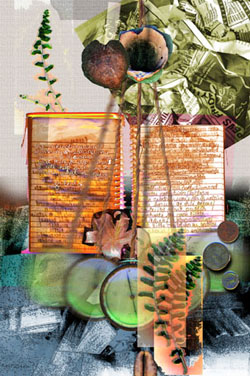|
The art of Rosscapili (b. 1959) with its single minded lyricism encompassing the shifting of many moods and feelings- subscribes to the prescription once written by the French Symbolist poet, Mallarme: “Paint not the thing but the effect the thing produces.” How apt and appropriate that message is, which can be gleaned, in one sweeping glance at the productive output of the artist-a stun of works that sustain the breadth of its technique. The implications of their spatial dynamism, achieved through the lyric exclamations of a water-soaked canvas or hardboard, suggest the immersion of the viewer in the illusionary space that the artist’s gestural moves have created. These are not a stock of images that the artist pulls out, like rabbits out of a hat, but rather, a flow of images that the material itself has so cunningly — and so blessedly — chose to manifest to the artist. To start with: the artist works on no preliminary study or visual guide. On the clean and immaculate slate of canvas no shadow emerges to lead the artist gladly to whichever direction. But with the first tentative markings on the pictorial space, the artist is led, not unlike the literary device of stream-of-consciousness, to gestures that define the design and compositional foundation of the painting — although that itself could vanish in the end. |
|
||
|
Essentially,
the artist works with acrylic and other water-based materials. As such,
the amalgamation of these materials results in the watery, aqueous variations
of colors which Rosscapili, like a well-practiced marksman, dispenses
on the canvas board with an almost balletic elegance. Quick to catch
the fast-drying acrylic, the artist engages in the stealthy manipulation
of his medium—wiping, scraping, scratching, mopping an errant,
excess liquidity—and all this with a purposeful intention to activate
the surface. The artist’s concentration focuses on the expressiveness
of the shapes, their finely modulated flow, their quiet eruptions as
the colors are keyed to the right and perfect lyrical pitch.
A pervading lightness dominates, no matter the scale of painting. Born in Tondo, he started schooling at the Isabelo de los Reyes where, in Grade Five, he discovered a knack for drawing. Never interested in academic studies, he would send notes to his teachers frankly informing them of his disinterest. Instead, he proffered to his teachers his art skills. His father (Fernando) was a tailor and his mother (Minerva) was a dressmaker. Because of the adverse financial situation of the family, the young Rossano used to clean vehicles in the Tondo streets to earn some pocket money. Helping out doing small billboards was another activity of the enterprising artist. At the Philippine College of Arts and Trades (now Technological University of the Philippines), Rosscapili studied drafting and ceramics technology. Later, he enrolled at the College of Fine Arts of the Philippine Women’s University—against the wishes of his parents who never considered art as a viable source of income. Two years into his art studies, an opportunity to work with the art department of Philippine Airlines came. Undergoing an entrance examination (testing the sociability and customer orientation of the applicant), the introvert Rosscapili failed. Nonetheless, his graphic skills saved the day for him. For 16 years he worked with PAL, until the time he decided to put up his own art and graphic design outfit, artCollaboration studio. Rosscapili’s introduction to the art scene came in 1975, when, at the invitation of Salva Limbo, curator of Silangan Art Gallery (now City Gallery), he joined group show on a religious theme. But even a year before that, he was already joining art competitions. In 1974 he placed second, both in the Rotary Club of Manila On-the-Spot Painting Competition and the Manila Council Nationwide Painting Competition. He also garnered first prize in the latter competition. From then on, the artist participated in many competitions. The recent ones are those of the Philippine Art Awards where he was a finalist in 1996; a Jurors’ Choice in the 1994 Philip Morris Asean Art Awards; and, also in 1994, a finalist in the Diwa ng Sining of the Rotary Club and NCCA. Married to an interior designer (Ellen) and father to two daughters (Kristen and Miro), Rosscapili’s artistic influence extends to his family. The 10-year-old Kristen recently won a top prize in the Northwest Orient Airlines-sponsored art competition. Kristen’s design—a jeepney! –was painted on the body of a Northwest Airlines plane, by means of a blow-up decal. Together with other winners from the region (Malaysia, Singapore, Japan), Kristen’s jeepney-inspired painting proudly carries the name “MANILA.” The other daughter, Miro was named after the great Spanish artist Joan Miro. No wonder, the young girl, at the age of five, has already taken up painting herself. Among Rosscapili’s admitted influences, pride of place is given to the American artist Paul Jenkins, whose giant canvases swim deliriously in waves and waves of merging colors. But unlike Jenkins who allows his liquid pigments a greater freedom, allowing the colors to seek their own directions and impulses, Rosscapili prefers to orchestrate, in the manner of a chromatic conductor, the elements of his art. From out of amorphousness, the artist directs the disposition of his shapes, colors and visual energies. |
|||
|
|
|||
